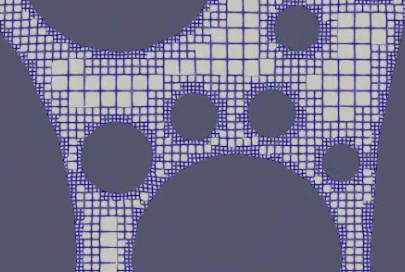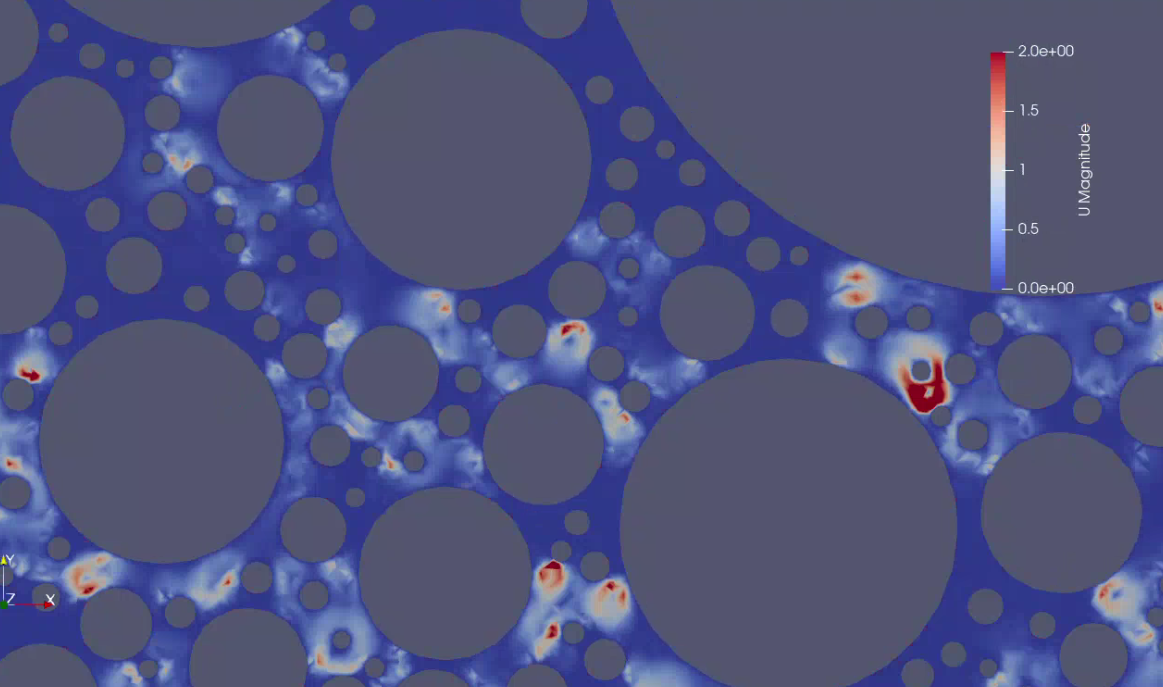 这是这是网格,现在的孔径在10微米左右
这是这是网格,现在的孔径在10微米左右
JDZhang
帖子
-
InterFoam求解孔隙尺度气液两相流中气泡内形成漩涡应如何解决 -
InterFoam求解孔隙尺度气液两相流中气泡内形成漩涡应如何解决@学流体的小明 拜托下能否给看下我的边界条件是否准确
/--------------------------------- C++ -----------------------------------
| ========= | |
| \ / F ield | OpenFOAM: The Open Source CFD Toolbox |
| \ / O peration | Version: 2312 |
| \ / A nd | Website: www.openfoam.com |
| \/ M anipulation | |
*---------------------------------------------------------------------------*/
FoamFile
{
version 2.0;
format ascii;
arch "LSB;label=32;scalar=64";
class volScalarField;
location "0";
object alpha.water;
}
// * * * * * * * * * * * * * * * * * * * * * * * * * * * * * * * * * * * * * //dimensions [0 0 0 0 0 0 0];
internalField uniform 1;
boundaryField
{
walls
{
type zeroGradient;
}
inLet
{
type codedFixedValue;
value uniform 1;
name inletProfile2;
code #{
const fvPatch& boundaryPatch = patch();
const vectorField& Cf = boundaryPatch.Cf();
scalarField& field = *this;scalar miny1 = 0.0e-3; scalar maxy1 = 0.005e-3;//gas两个数中间进气 scalar miny2 = 0.01e-3; scalar maxy2 = 0.015e-3;//gas两个数中间进气 scalar miny3 = 0.02e-3; scalar maxy3 = 0.025e-3;//gas两个数中间进气 scalar miny4 = 0.03e-3; scalar maxy4 = 0.035e-3;//gas两个数中间进气 scalar miny5 = 0.04e-3; scalar maxy5 = 0.045e-3;//gas两个数中间进气 scalar miny6 = 0.05e-3; scalar maxy6 = 0.055e-3;//gas两个数中间进气 scalar miny7 = 0.06e-3; scalar maxy7 = 0.065e-3;//gas两个数中间进气 scalar miny8 = 0.07e-3; scalar maxy8 = 0.075e-3;//gas两个数中间进气 scalar miny9 = 0.08e-3; scalar maxy9 = 0.085e-3;//gas两个数中间进气 scalar miny10 = 0.09e-3; scalar maxy10 = 0.095e-3;//gas两个数中间进气 forAll(Cf , faceI) { if( (Cf[faceI].y() > miny1) && (Cf[faceI].y() < maxy1) ) { field[faceI] = 0; } if( (Cf[faceI].y() > miny2) && (Cf[faceI].y() < maxy2) ) { field[faceI] = 0; } if( (Cf[faceI].y() > miny3) && (Cf[faceI].y() < maxy3) ) { field[faceI] = 0; } if( (Cf[faceI].y() > miny4) && (Cf[faceI].y() < maxy4) ) { field[faceI] = 0; } if( (Cf[faceI].y() > miny5) && (Cf[faceI].y() < maxy5) ) { field[faceI] = 0; } if( (Cf[faceI].y() > miny6) && (Cf[faceI].y() < maxy6) ) { field[faceI] = 0; } if( (Cf[faceI].y() > miny7) && (Cf[faceI].y() < maxy7) ) { field[faceI] = 0; } if( (Cf[faceI].y() > miny8) && (Cf[faceI].y() < maxy8) ) { field[faceI] = 0; } if( (Cf[faceI].y() > miny9) && (Cf[faceI].y() < maxy9) ) { field[faceI] = 0; } if( (Cf[faceI].y() > miny10) && (Cf[faceI].y() < maxy10) ) { field[faceI] = 0; } } #}; } outLet { type zeroGradient; } front { type empty; } back { type empty; } sand { type constantAlphaContactAngle; theta0 45; limit gradient; value uniform 0; } //hydrate //{ // type constantAlphaContactAngle; // theta0 34; // limit gradient; // value uniform 0; //} clay { type constantAlphaContactAngle; theta0 24; limit gradient; value uniform 0; }}
// ************************************************************************* //
/--------------------------------- C++ -----------------------------------
| ========= | |
| \ / F ield | OpenFOAM: The Open Source CFD Toolbox |
| \ / O peration | Version: 2312 |
| \ / A nd | Website: www.openfoam.com |
| \/ M anipulation | |
*---------------------------------------------------------------------------*/
FoamFile
{
version 2.0;
format ascii;
class volScalarField;
object p_rgh;
}
// * * * * * * * * * * * * * * * * * * * * * * * * * * * * * * * * * * * * * //dimensions [1 -1 -2 0 0 0 0];
internalField uniform 0;
boundaryField
{
inLet
{
type fixedFluxPressure;
}
outLet
{
type fixedValue;
value uniform 0; // 指定出口压力
}walls { type zeroGradient; } front { type empty; } back { type empty; } sand { type zeroGradient; } //hydrate //{ // type fixedFluxPressure; //} clay { type zeroGradient; }}
// ************************************************************************* //
/--------------------------------- C++ -----------------------------------
| ========= | |
| \ / F ield | OpenFOAM: The Open Source CFD Toolbox |
| \ / O peration | Version: 2312 |
| \ / A nd | Website: www.openfoam.com |
| \/ M anipulation | |
*---------------------------------------------------------------------------*/
FoamFile
{
version 2.0;
format ascii;
class volVectorField;
location "0";
object U;
}
// * * * * * * * * * * * * * * * * * * * * * * * * * * * * * * * * * * * * * //dimensions [0 1 -1 0 0 0 0];
internalField uniform (0 0 0);
boundaryField
{
inLet
{
type codedFixedValue;
value uniform (1e-2 0 0);//液体速度
name inletProfile1;code #{ const fvPatch& boundaryPatch = patch(); const vectorField& Cf = boundaryPatch.Cf(); vectorField& field = *this; scalar miny1 = 0.0e-3; scalar maxy1 = 0.005e-3;//gas两个数中间进气 scalar miny2 = 0.01e-3; scalar maxy2 = 0.015e-3;//gas两个数中间进气 scalar miny3 = 0.02e-3; scalar maxy3 = 0.025e-3;//gas两个数中间进气 scalar miny4 = 0.03e-3; scalar maxy4 = 0.035e-3;//gas两个数中间进气 scalar miny5 = 0.04e-3; scalar maxy5 = 0.045e-3;//gas两个数中间进气 scalar miny6 = 0.05e-3; scalar maxy6 = 0.055e-3;//gas两个数中间进气 scalar miny7 = 0.06e-3; scalar maxy7 = 0.065e-3;//gas两个数中间进气 scalar miny8 = 0.07e-3; scalar maxy8 = 0.075e-3;//gas两个数中间进气 scalar miny9 = 0.08e-3; scalar maxy9 = 0.085e-3;//gas两个数中间进气 scalar miny10 = 0.09e-3; scalar maxy10 = 0.095e-3;//gas两个数中间进气 forAll(Cf , faceI) { if( (Cf[faceI].y() > miny1) && (Cf[faceI].y() < maxy1) ) { field[faceI] = vector(1e-2, 0, 0);//气体速度 } if( (Cf[faceI].y() > miny2) && (Cf[faceI].y() < maxy2) ) { field[faceI] = vector(1e-2, 0, 0);//气体速度 } if( (Cf[faceI].y() > miny3) && (Cf[faceI].y() < maxy3) ) { field[faceI] = vector(1e-2, 0, 0);//气体速度 } if( (Cf[faceI].y() > miny4) && (Cf[faceI].y() < maxy4) ) { field[faceI] = vector(1e-2, 0, 0);//气体速度 } if( (Cf[faceI].y() > miny5) && (Cf[faceI].y() < maxy5) ) { field[faceI] = vector(1e-2, 0, 0);//气体速度 } if( (Cf[faceI].y() > miny6) && (Cf[faceI].y() < maxy6) ) { field[faceI] = vector(1e-2, 0, 0);//气体速度 } if( (Cf[faceI].y() > miny7) && (Cf[faceI].y() < maxy7) ) { field[faceI] = vector(1e-2, 0, 0);//气体速度 } if( (Cf[faceI].y() > miny8) && (Cf[faceI].y() < maxy8) ) { field[faceI] = vector(1e-2, 0, 0);//气体速度 } if( (Cf[faceI].y() > miny9) && (Cf[faceI].y() < maxy9) ) { field[faceI] = vector(1e-2, 0, 0);//气体速度 } if( (Cf[faceI].y() > miny10) && (Cf[faceI].y() < maxy10) ) { field[faceI] = vector(1e-2, 0, 0);//气体速度 } } #}; } outLet { type zeroGradient; } walls { type noSlip; } front { type empty; } back { type empty; } sand { type noSlip; } //hydrate //{ //type noSlip; //} clay { type noSlip; }}
// ************************************************************************* //
-
InterFoam求解孔隙尺度气液两相流中气泡内形成漩涡应如何解决这是速度云图,可以看出,气相区域的速度显著高于入口的气相速度2e-3,不符合物理常识,请各位赐教,该如何解决这个问题呢

-
微管道中taylor bubble flow 不出现涡流我是在多孔介质里面模拟气液两相流,为什么我的速度流线是这样的呢,蓝色气泡位置的流速很大

-
InterFoam求解孔隙尺度气液两相流中气泡内形成漩涡应如何解决各位大神好,我通过InterFOAM和VOF跑气液两相流过程中,气液混合注入时入口速度仅1e-3m/s,但孔隙内的气泡速度达到4m/s的量级。
通过流线发现,气泡内形成涡,自身旋转造成了很大的流速,这应该如何解决呢。


-
求大佬!请问模拟砂、黏土共存的多孔介质时,不同介质颗粒表面如何设置不同接触角,网格该如何处理@bestucan 感谢老师的回答,老师,您好,模型我已经画出来了,砂颗粒一个模型、黏土颗粒一个模型,现在就是不知道如何去画网格,可以使砂颗粒与黏土表面分别是一个wall面,然后设定两个接触角。例如图中,灰色所有球表面设置一个接触角、绿色所有球表面设置一个接触角。还请老师不吝赐教,谢谢!

-
求大佬!请问模拟砂、黏土共存的多孔介质时,不同介质颗粒表面如何设置不同接触角,网格该如何处理各位前辈,目前在做砂、黏土共存的多孔介质时,画网格时整个多孔介质固体颗粒表面作为了一个wall,这种情况只能设置一个接触角。请问如何在多孔介质模型中的砂颗粒表面设置wall,黏土颗粒表面设置另一个wall,进而设置不同的接触角呢。该如何画网格呢,有没有推荐的商软、或者相关的链接,谢谢各位!
